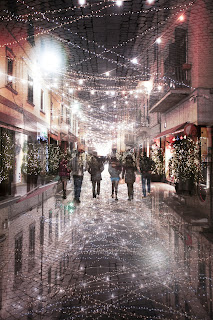DISSONANCES
Interactive installation: small-format holed photos that can be played through a tape music box movement machine.
Size cm: 15x51x20 - year 2020
The period after the lockdown imposed by the pandemic, saw the slow resumption of daily activities, in social distancing.
The perceived unease at the sight of gatherings, and the desire to try to avoid the invisible viral enemy, lead us to imagine the stranger as dangerous, unwelcome. The strangers seem blind, they do not see the enemy that is all around. This chaos is almost everywhere, dissonant.
Since the beginning of the pandemic, I have tried to describe in photography the sense of perceived unease: the holes in the photos are the key to this unease. The hole is essentially something you can't see anymore: what was there in the photo? At the same time the pierced photo places us in front of a partially damaged object, no longer intact. Finally the hole plays, and it plays bad. In a tape music box movement machine, the position of the holes is strategic to produce good melodies: piercing the photos around people to represent that invisible virus, you always get out of tune chords. This is what you can feel when you see groups of people: "How can they not realize that they are practically next to it? Why do they decide to ignore it?"
Since the beginning of the pandemic, I have tried to describe in photography the sense of perceived unease: the holes in the photos are the key to this unease. The hole is essentially something you can't see anymore: what was there in the photo? At the same time the pierced photo places us in front of a partially damaged object, no longer intact. Finally the hole plays, and it plays bad. In a tape music box movement machine, the position of the holes is strategic to produce good melodies: piercing the photos around people to represent that invisible virus, you always get out of tune chords. This is what you can feel when you see groups of people: "How can they not realize that they are practically next to it? Why do they decide to ignore it?"
DISSONANZE
Installazione interattiva: foto bucate di piccolo formato che possono essere letteralmente suonate attraverso un carillon a nastro.
Misure cm: 15x51x20 - anno 2020
Da un lato, il disagio percepito alla vista di assembramenti, dall’altro, il voler cercare di evitare il nemico invisibile del virus, ci porta ad immaginare l’estraneo come pericoloso, sgradito. Insieme a tutto questo, l’estraneo sembra cieco, non vede il nemico che è tutto intorno. Questo caos è quasi ovunque, dissonante.
Ho cercato fin da inizio della pandemia di descrivere in fotografia il senso di disagio percepito: i buchi nelle fotografie sono la chiave di questo disagio. Il buco è essenzialmente qualcosa che non si può vedere: cosa c'era in quel punto della fotografia? Allo stesso tempo la foto bucata ci pone di fronte ad un oggetto parzialmente rovinato, non più integro. Infine il buco suona, e suona male. Nei carillon a nastro, la posizione dei buchi è strategica per far suonare delle buone melodie: bucando le foto attorno alle persone per rappresentare quel virus invisibile, si ottengono praticamente sempre degli accordi stonati. Questo è quello che si prova nel vedere il gruppo di persone vicine tra loro: "Come fanno a non accorgersi di essergli praticamente accanto? Perché decidono di ignorarlo?"
 |
| L'installazione |
credits
font used: National First Font Dotted - Roger White


